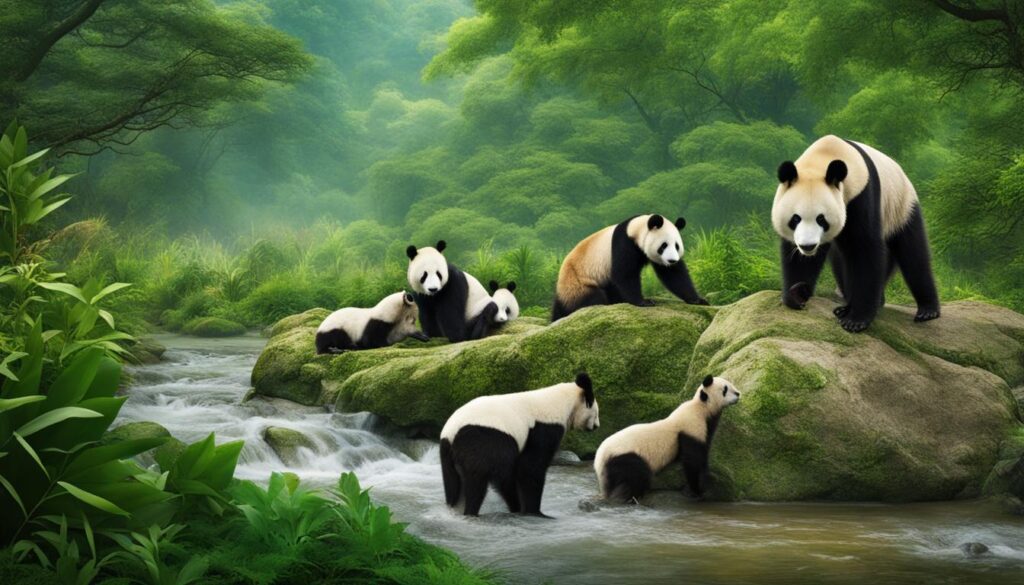China is a country known for its incredible biodiversity and diverse array of wildlife. From the iconic giant panda to the unique species native to its landscapes, China is home to some of the most fascinating animals in the world.
Among the famous animal species in China is the giant panda. Endemic to China, these adorable creatures are a symbol of the country’s commitment to wildlife conservation. However, they are also classified as an endangered species, highlighting the challenges faced by animals in China’s changing environment.
In addition to the giant panda, China is home to many other notable animal species. The Tibetan macaque, Chinese giant salamander, golden snub-nosed monkey, and Chinese sturgeon are just a few examples of the diverse wildlife that can be found in China’s habitats.
The country’s landscapes provide a variety of animal habitats, including forests, rivers, and mountains. These habitats support a rich biodiversity, with approximately 7,516 species of vertebrates, including fish, birds, mammals, reptiles, and amphibians.

Key Takeaways:
- China is home to a diverse array of wildlife, including the iconic giant panda.
- Many animal species in China are native only to this country.
- China’s landscapes support a rich biodiversity, with over 7,500 species of vertebrates.
- The giant panda is classified as an endangered species, highlighting the need for animal conservation in China.
- Other notable animal species in China include the Tibetan macaque, Chinese giant salamander, golden snub-nosed monkey, and Chinese sturgeon.
Endangered Species in China
China’s wildlife is facing a critical challenge as many species are now endangered or at risk of extinction. The extensive human activities in the country, including habitat destruction, pollution, and the illegal hunting of animals for food and traditional Chinese medicine ingredients, pose grave threats to their survival.
To counter these threats and protect the rich biodiversity of China, the government has taken significant steps in animal conservation and protection. With more than 2,349 nature reserves covering 15 percent of the country’s land area, China has created a crucial network of protected areas to safeguard endangered wildlife and their habitats.
These nature reserves play a vital role in preserving the unique flora and fauna of China. By providing safe havens for endangered animals, they ensure their continued existence and contribute to the overall conservation efforts in the country.
| Threats to Wildlife | Conservation Efforts |
|---|---|
|
|
Unique Animal Species in China
China boasts a rich diversity of unique animal species that cannot be found anywhere else in the world. Among these extraordinary creatures is the snub-nosed monkey, a native primate species known for its distinct appearance and behavior. Another notable Chinese wildlife species is the Chinese giant salamander, the largest amphibian on the planet. With its astounding size and fascinating characteristics, the Chinese giant salamander captures the imagination of nature enthusiasts worldwide. Additionally, the golden snub-nosed monkey stands out for its striking golden fur and remarkable adaptations to thrive in cold climates. These enchanting animals are specifically adapted to thrive in the diverse habitats of China, such as mountainous forests and rivers, and play a crucial role in maintaining the country’s ecological diversity.

China’s unique animal species contribute significantly to the global biodiversity and showcase the country’s commitment to wildlife preservation. Their presence in the country’s diverse habitats reflects the importance of protecting these natural environments for future generations. By focusing on the conservation of animals native to China, we can ensure the survival of these remarkable species and maintain the delicate balance of ecosystems within the region.
Conservation Efforts in China
China understands the crucial significance of conserving its unique and diverse wildlife, and has taken significant measures to protect and preserve these precious animals. The country has implemented laws that provide legal protection to endangered wildlife, ensuring their safety and well-being. Additionally, China has established numerous nature reserves and protected areas to safeguard critical habitats and ecosystems.
Conservation organizations and research institutions in China collaborate on various initiatives aimed at studying and monitoring animal populations, implementing effective conservation programs, and raising awareness about the importance of wildlife conservation. These efforts play a vital role in safeguarding the future of China’s animals and promoting sustainable practices for their long-term survival.
“China’s commitment to wildlife conservation and the establishment of nature reserves demonstrate the country’s dedication to preserving its rich natural heritage. These conservation efforts not only protect endangered species but also contribute to the overall ecological balance and biodiversity of China.”
By prioritizing animal conservation and protection, China showcases its commitment to preserving its diverse and unique wildlife for future generations to enjoy. These efforts contribute to the overall well-being of ecosystems, the economy, and the overall balance of nature. Through ongoing conservation initiatives, China showcases its leadership and dedication in global wildlife conservation efforts.

| Conservation Efforts | Benefits |
|---|---|
| Establishment of nature reserves | Preserves critical habitats and protects endangered species |
| Collaboration with conservation organizations and research institutions | Enables the study and monitoring of animal populations, implementation of effective conservation programs, and raising awareness |
| Protection laws for endangered wildlife | Safeguards the legal status and well-being of endangered species |
Conclusion
China’s rich biodiversity and unique animal species make it a significant hub for wildlife conservation. The country’s commitment to protecting endangered species and their habitats, along with ongoing research and conservation efforts, contribute to the preservation of China’s natural heritage.
By promoting sustainable practices and raising awareness about the importance of wildlife conservation, China plays a vital role in ensuring the survival of its diverse array of animal species for future generations to enjoy.
From iconic animals like the giant panda to lesser-known species such as the Chinese giant salamander and golden snub-nosed monkey, Chinese wildlife is a treasure worth protecting. Through the establishment of nature reserves, the implementation of conservation laws, and collaborative efforts between conservation organizations and research institutions, China aims to safeguard its unique animal populations.
Ultimately, the conservation of animals in China is not only important for their individual survival, but also for the overall health and balance of ecosystems. It is through these collective efforts that China showcases its dedication to preserving its natural heritage, and sets an example for the rest of the world in the conservation of wildlife.
FAQ
What are some of the endangered species in China?
Some of the endangered species in China include the giant panda, Tibetan macaque, Chinese giant salamander, golden snub-nosed monkey, and Chinese sturgeon.
What are some unique animal species found in China?
China is home to unique animal species such as the snub-nosed monkey, Chinese giant salamander, and golden snub-nosed monkey.
What are the main threats to wildlife in China?
Some of the main threats to wildlife in China include habitat destruction, pollution, and poaching for food and traditional Chinese medicine.
What measures has China taken to protect its wildlife?
China has established over 2,349 nature reserves covering 15 percent of the country’s total land area to protect and conserve endangered wildlife. The country’s laws provide protection for endangered species, and conservation organizations and research institutions collaborate on conservation initiatives.
Why is wildlife conservation important in China?
Wildlife conservation is important in China to preserve the country’s rich biodiversity, protect endangered species, and ensure the long-term survival of its unique animal species for future generations.
